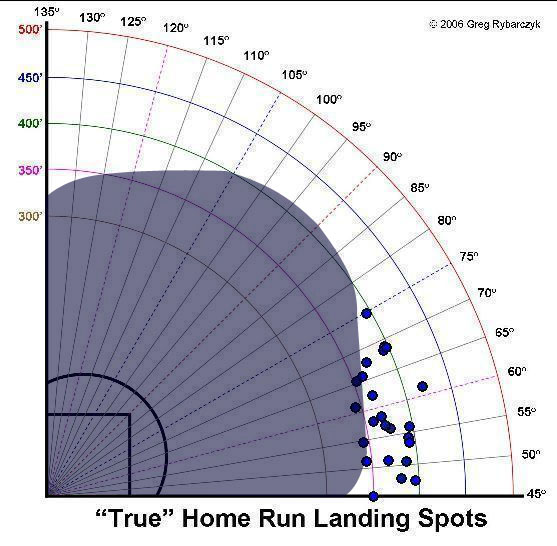One line we’ve parroted this off-season is that Johnny Damon is more valuable to the Yankees than any other team because his plate skills align well with Yankee Stadium. With the shorter porch in right, Damon can turn what would be fly balls in other parks into home runs. Yet it’s tough to determine just how many of his home runs would have stayed in other parks. That is, until the Ballpark Overlay Tool. Using this and Hit Tracker, we can see how the same hits would have landed in other home ballparks.
The tool is quite basic. It’s a 1.2MB Photoshop file consisting of 31 layers. The first 30 represent the dimensions of each major league ballpark. The last is for our manipulation. By going to a player’s home run chart on Hit Tracker, we can paste the image onto that 31st layer, unhide the layer of the appropriate ballpark, and make our observations. So let’s look at Damon’s 2009 home runs from the perspective of Turner Field and AT&T Park, homes of the Braves and Giants, two potential Damon suitors.
Damon at Turner Field:

Damon at AT&T Park:

It looks like at least seven of Damon’s Yankee Stadium home runs would have stayed in the park at Turner, and six would have stayed in at AT&T — though there are four home runs on the borderline. So, while Damon still would have hit a healthy number of home runs at AT&T Park and Turner field, there would certainly be a drop-off, especially on the home runs towards right-center. That’s where he took the greatest advantage of Yankee Stadium.
Of course, things change from year to year, and in Damon’s case, so would the pitchers. This in no way means that Johnny will hit six or seven fewer home runs at home if he signs with the Braves or Giants. Bill Baer of Crashburn Alley explains in the comments on Capitol Avenue Club:
I think it should be noted, however (NERD ALERT!), that in using this for analysis one can’t just say, “X amount of Player’s homers in Old Ballpark would not have been homers in New Ballpark, so he should be expected to hit X less home runs.”
Albert Pujols, one of the most consistent power hitters in the game, has a standard deviation of 6 HR per season with an average of 41. That means that roughly 68% of the time, we expect Pujols to hit between 35-47 HR, and 29-53 HR 95% of the time. So, if he was moving to Seattle, we could point out that X amount of his HR wouldn’t have cleared the fence at Safeco, but he would have to have hit a lot of cheapies for it to affect our analysis of his power output.
This overlay analysis requires one to effectively chop the available sample size in half, which certainly raises the uncertainty level, especially with younger players.
The post’s author goes on to note other factors which would affect a player’s home run totals in other ballparks, including wind and fence height. There’s also the issue of long fly balls that stay inside larger ballparks but would fly out of others. I’m not so sure that makes a big difference in Damon’s case. I don’t remember him smashing balls the opposite way very often, and it’s in left-center that Yankee Stadium is at its most spacious.
Still, it’s an interesting tool that can help us better understand how a ballpark factors into a player’s performance. It leaves many questions unanswered — in addition to those above, the question of whether Damon shoots for the fence at YS remains a mystery — but I think it makes pretty clear that Damon’s power at other home ballparks just wouldn’t be the same as in Yankee Stadium. That factor, perhaps, is the leading reason for Damon’s return to the Bronx.
Glove slap to Tango for the link.
If you want to play with the tool, you’ll need either Adobe Photoshop or GIMP. You can then download the Ballpark Overlay Tool. Once you open it up, head to Hit Tracker and find a player. Right click on his home run chart and select Copy Image. Paste that into the Player layer and unhide the ballpark you want to examine. It’s a damn entertaining tool, I must say.
Update: Commenter JGS asked that I overlay Damon’s home runs over Yankee Stadium, and I’m glad he did.

Hmm…I guess there’s a reason that the Ballpark Overlay Tool is still in beta testing.
Leave a Reply
You must be logged in to post a comment.